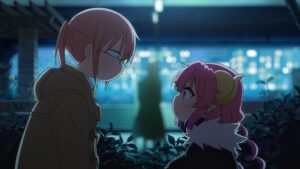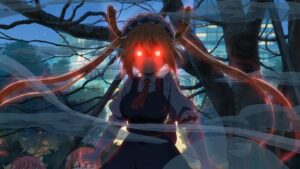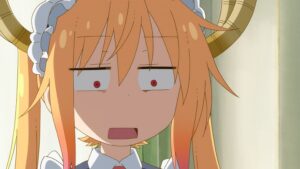After a week of the Internet wringing its collective hands over the “gift” given to Kobayashi-san in the previous episode, it only lasted for seven minutes of this one. I had little doubt that this adaptation would resolve the issue quickly (its first season apparently skirted a lot of weirdness from the manga, as well), but I’m pleased nonetheless. Dragon Maid is an anime with a lot going for it, but those positives are already difficult enough for traditional audiences to glimpse without the author’s fetishes further clouding their vision. Of course, we had to go through Kobayashi’s trials as the new owner of a dangling appendage first, with a new waste disposal routine and her roommate’s bountiful breasts to threaten the status quo, but all was resolved before long. I think we were meant to infer that Tohru shedding her precious outfit was what restored a disappointed Kobayashi to her former self – in the end she’s just a maidsexual programmer, regardless of whatever biological forces are imposed on her.
Even these awkward scenes possessed plenty of the series’ charming animation, with squash frames highlighting Kobayashi’s discomfort in the bath and nearly imperceptible smears to illustrate her swift withdrawal from uncomfortable situations. But it was the art on display in the second act, and particularly the lighting, that really impressed me. I’ve never attended closely to the various dragon clans in this series, but the interloper from the harmony faction cast a shadow over this episode like we’ve never seen in Dragon Maid, and the soft glow of street lamps and illuminated windows were crucial in balancing that darkness. While Tohru was the one to send him packing (in brutal and obliviating fashion), it was Kobayashi who destroyed his primary argument that Ilulu could never coexist with humans. By protecting Ilulu from harm, recognizing her inner conflict, and offering her a place to belong, Kobayashi served as a matching light in Ilulu’s pitch dark world, creating a wonderful link between the visuals and the underlying emotions of their scenes together.
The parallel between Ilulu, who was trained to hate humans after they caused the death of her parents, and Kobayashi, who learned to sever personal relationships in favor of dedicating herself to a company, worked reasonably well by itself. What clinched it for me, though, was the fact that Ilulu had enjoyed playing with humans in her youth – a source of pleasure that was ripped away from her after the attack on her family. That sense of loss mirrors the feelings of many adults who experience tragedy in their childhoods, and are forced to grow up before their time. That’s a profound background for a character whose boobs are the size of beach balls, but there doesn’t need to be a disconnect there. That’s something I learned from the first season of Dragon Maid four years ago – unrealistic character designs, and even oversexualized ones, don’t prohibit a series from saying something worthwhile. They may be good indicators that you’re about to watch something vapid in 80 percent of cases, but Dragon Maid lands at the very top of that remaining 20 percent, and I’m glad that both it and Kyoto Animation have returned to bring a bit of insight to this summer season.





If people can look past the “fan service” elements of the show, they will find a charming and heartfelt story about family.
I agree. Manga authors need to be less self indulgent. Its probably even ruined some works. Kobayashi is good enough that it can still take the hits but its definitely a lesser show as a result
I would not call the show lesser and anyone who think that are too focused on the bad to appreciate the good